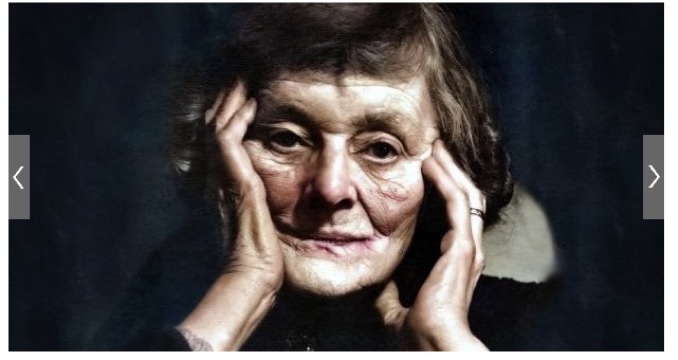Maud Gonne was a rich and powerfully connected woman who dedicated her long life to a variety of political and social causes–cultural, feminist, labor, nationalist, penal, social and spiritual emancipation. A passionate advocate for Irish and female independence, when these were unpopular positions, she was a fervent and effective activist, and a significant figure in Irish artistic, amnesty and social reform movements.
Her political and social achievements were considerable by any measure. They were also unique and diverse and debatable.
Once, she was famous throughout Ireland and Irish-America, but today her achievements are mostly known to a small group of historians and their readers and followers. A group of us want to change that and see her honored with a street statue in Dublin.
Gonne was no straightforward (s)hero. She has attracted widespread adulation and admiration, especially from women, and widespread criticism and suspicion, especially from men. She not only understood the connections and tensions between national and female suppression, she embodied them in her life.
And she translated that understanding into meaningful protests, both symbolic and practical.
I have been writing about her for more than two decades and I still find new angles and aspects to this compelling and complex woman. Her lifelong focus on freedom, constraint and abandonment has its roots in her personal experience as an army orphaned child, and is the recurring theme in my upcoming novel series about her life and times.
Like us all, Maud Gonne's politics were personal. She was over six-feet tall with a personality that was too big for her life and times.
Her story is important and remains highly relevant today.
Maud Gonne: More Than A Muse Presentation
As part of raising awareness for the book launch and campaign, I'm working on a presentation “More than a Muse” that will introduce the breadth and depth of this influential, inspiring, and elegant woman to as many people as possible.
I'll deliver this first to a live audience at Kino-Teatr, St Leonards, on St Patrick's Day, and will make an online version available also.
The aim is to start a series of discussions, with all who are interested, about all she did, explain why she (and more women) deserve a statue in Dublin, and invite people to join the campaign on Kickstarter.
Irish republicanism, women's rights, and justice for prisoners were always linked for Gonne.
Below is the bullet-point outline of my talk, and some of the images I'll use in the presentation. I'll also produce an online version.
Sign up here to learn more about the campaign, and my novel series about Gonne, Yeats
Sign here to join the statue campaign on Kickstarter
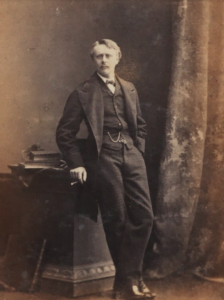
Maud Gonne: More Than A Muse
Background: Brief overview of Maud Gonne's life and why this Irish revolutionary, journalist, feminist, philanthropist, actor and artist, mother, penal and amnesty activist and humanitarian was important. And why she has been so easily, and repeatedly, denigrated.
Maud Gonne's activism, literary contributions, and political involvement in the quest for Irish independence not only shaped the course of history but also inspired generations.
1. Influences and Political Awakening: 1880 to 1888
Background: Born in England in 1866, early years travelling between France, England and Ireland
- 1880s: Madame, her Republican French governess and Tommy, her father, an officer in the British army
- 1885: Moves to Ireland, when Tommy is appointed Assistant Adjutant in British Army.
- Debut at Dublin Castle.

- 1886: See first eviction and Tommy plans to leave army and become a Home Rule candidate
- Tommy dies and she is sent to her patriarchal Uncle William in London.
- 1887: Comes into her inheritance, giving her an independence unknown to most other women of the time.
- Meets Lucien Millevoye, a married journalist with fervid right-wing politics, a supporter of General Boulanger, and a revanchist, later a deputé in French parliament. Inherits trust funds and an unentailed sum from her mother's estate. Her liaison with Millevoye was motivated by both passion and politics; he aimed to restore France's glory by reclaiming Alsace-Lorraine, while her focus was on liberating Ireland. United, they formed an “alliance” in opposition to the British empire.
- 1888: Clandestine Boulangist mission to Russia
- Sets up an apartment over Morrow's bookshop in Dublin's Nassau St.
- Exchanges “Éire” rings with Ida Jameson, daughter of a staunchly unionist family, testament to their shared commitment to home rule.
- Both are invited by him to the meetings of the Contemporary Club at 116 Grafton Street, the only women allowed in.
- Befriends the old Fenian John O'Leary and his sister Ellen, along with George Russell (AE) and many others, and spends much time at his house reading Young Irelander books and other canonical nationalist texts, including ‘Speranza', Lady Wilde, the mother of Oscar.
- Witnesses evictions of Irish tenants and horrendous incarcerations of Irish political prisoners. Determines to become Ireland's “Joan of Arc”–involved with the Plan of Campaign in Donegal and elsewhere.
2. Early Activism: 1889 to 1898
Background: The Land Wars in Ireland (1879-1882). Rent racking, famines, and evictions. The Irish Republican Brotherhood, later the IRA, and attitudes to women (refused entry). Use of her beauty (Stead: ‘the most beautiful woman in the world’) to wield influence.
- 1889: Calls to Yeats home in Bedford Park and involved in amnesty campaigns in Britain
- Given introductions to Michael Davitt, who was suspicious of her, and to Timothy Harrington , who saw her propaganda potential
- 1890: Takes her cousin May Gonne and giant dog Dagda to the Olphert estate in Falcarragh, where she dined with the bishop and parish priests, and galvanised local opinion.
- Paris apartment at 61 Avenue Wagram, birth of her son, Georges Sylvère (Jan)
- Campaigns with Harrington on the electoral platform for the home rule candidate D. Duncan at Barrow-in-Furness, Lancashire (June)
- Lectures on the horrors of eviction to English audiences, and visits long-term Fenian prisoners in Portland jail. Yeats dubs her ‘the new Speranza
- Inspired by the journal Shan Van Vocht, forms Irish radical nationalist publication L’Irlande Libre, to be distributed in France and around Europe.
- 1891: Death of son, Georges (August)
- Writes Yeats a letter of ‘wild sorrow’ telling him that an ‘adopted’ child had died
- Travels to Dublin on 11 October on the boat that carries Parnell's coffin, in deep mourning for her son, thought to be theatrically grieving the lost leader.
- Yeats comforts her, he and Russell instruct her in rituals of reincarnation
- Initiated into the Order of the Golden Dawn in London (Nov).
- 1892:
- 1893: Reincarnation of son in ritual inspired by Yeats and George Russell (Æ)
- 1894: Birth of daughter, Iseult
- 1895: Returned to work for her various nationalist and political organisations, notably the Amnesty Association
- 1896 onwards: Contributed personal funds to Arthur Griffith’s newspaper the United Irishman, which she also wrote and fundraised for.
- 1898: Proposal to Yeats
3. Cultural Activism
Background: Role in the Celtic Revival alongside figures like Æ, Augusta Gregory, Arthur Griffith, Douglas Hyde, Constance Markievicz, WB Yeats, and Ella Young.
-
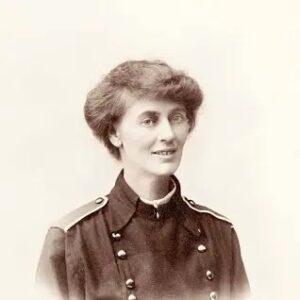
Constance Markievicz sister activist and rebel, with whom Maud Gonne is often confused Literary nationalism: Drama and the arts to further political aims: Yeats poetry in her life
- 1902: Lead role in ‘Cathleen Ni Houlihan’, Yeats's and Lady Gregory's play at their new national theatre, The Abbey
- Personal art and writings–Dawn, about British brutality and irresponsibility in the famine years;
- coauthored “The Right to Life and The Rights of Property” with socialist James Connolly
4. “Advanced” Irish Nationalism
Background:
- 1898: Cenntenial commemorations of 1798 rebellions and Hoche statues in Mayo
- 1900: Gonne (36) organised a patriotic children’s picnic, to counter the one organised in celebration of Queen Victoria's visit to Dublin.
- 1900: Forms Inghinidhe na hÉireann (Daughters of Ireland) in 1900, a women's organization to promote Irish culture and political independence.
- 1903: Marriage to John MacBride
-
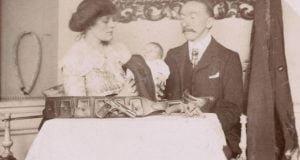
Maud Gonne and John MacBride with their son, Seán, revolvers and bullets on the table. 1904: Birth of son, Sean MacBride and docu-drama Dawn published in United Irishmen
- 1905: Divorce and its impact on her political engagement. Rejection by the most powerful Irish nationalists
- 1908 through 1911: Inghinidhe's newspaper Bean na hEireann (Woman of Ireland) “Freedom for our nation and the complete removal of all disabilities to our sex.”
6. Social Activism
Background: Work for the poor and disenfranchised, especially children.
- 1912: Paris schoolchildren
- 1914: Stance against World War I and her work with the White Cross for war relief.
7. Irish War of Independence and Civil War
- 1916: In Paris when she reads of the Rising and MacBride's arrest … must get to Ireland
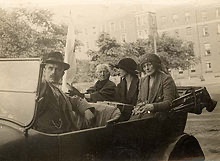
Maud Gonne, Charlotte Despard and other Anti-treaty Activists - 1918, Gonne accused of assisting the falsified “German plot,” and imprisoned alongside Constance Markievicz, Kathleen Clarke, and Hanna Sheehy Skeffington in Holloway women’s prison in London.
- Opposition to the Anglo-Irish Treaty of 1921: Advocacy for a complete break from Britain.
- Civil War with Iseult and Francis Stuart
8. Legacy and Impact
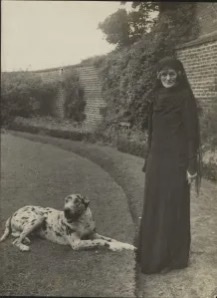
Gonne's activism against injustice, particularly that on behalf Irish political prisoners, deeply influenced her son, Sean MacBride, shaping his commitment to peace and human rights. This influence laid the foundation for MacBride's role in co-founding Amnesty International, an organization focused on protecting human rights worldwide.
Honoring Gonne with a statue would recognize her indirect yet profound influence in the creation of this leading human rights organization, highlighting the impact mothers can have on shaping their children's values and actions. In this way, the statue would also celebrate the broader power of maternal influence.
- Legacy: Contributions to Irish (partial) independence, to socialism and feminism, penal reform and Amnesty international.
- Impact: Memorials, writings, and how she is viewed today.
- Complexity: Terrorist turned pacifist; visionary turned Roman Catholic, socialist humanitarian and right-wing anti-Semite
- Diversity: Perfect role model for our time. Illustrating the diverse roles women have played in history, beyond their relationships with men but also beyond the need to be perfect.Women are not saints, any more than men.
- More than a Muse: “Statue for Maud” campaign
I'll issue the finished presentation here soon!
